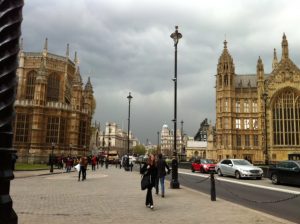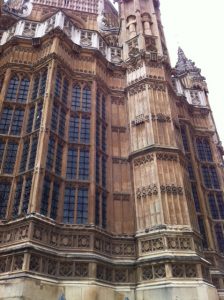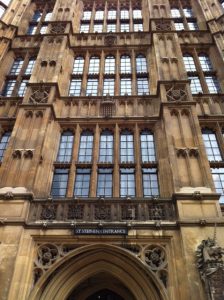The use of the Portcullis as a specifically Parliamentary symbol is not a particularly ancient one. In fact it dates from the building of the new Palace of Westminster the 19th century. The genius of Charles Barry’s design for the west front of the Palace (below right) was – among other things – to match it to the appearance of the Henry VII Chapel of Westminster Abbey, directly across Old Palace Yard (below left).
The Chapel was studded with stone Portcullises. These little stylised gates were in fact the heraldic badge of Lady Margaret Beaufort (1443-1509), Henry VII’s fearsome and brilliant mother, hence its use on the chapel he endowed in the first decade of the 16th century. No doubt there were some Portcullises in the buildings and decorations of the old Palace of Westminster from the time of Henry VII and the early reign of Henry VIII (the royal family moved out after a fire in 1512/13). But their purpose was to signal the presence of work commissioned under those kings, not to symbolise Parliament as an institution.
However, Charles Barry was so taken with it as a symbol that he used it to identify his plans when they were submitted anonymously to the competition judges assessing designs for the new Palace in 1836. Pugin later used it extensively for the interior design of the Palace – it is the essence of neo-gothic, and can be seen everywhere from wallpapers to chairs to carpets. In the 21st century the symbol has come to stand for the House of Lords (red) and the House of Commons (green), and like any other trademark its use is strictly controlled.

And now, spot the difference between these two buildings displaying Portcullises…


